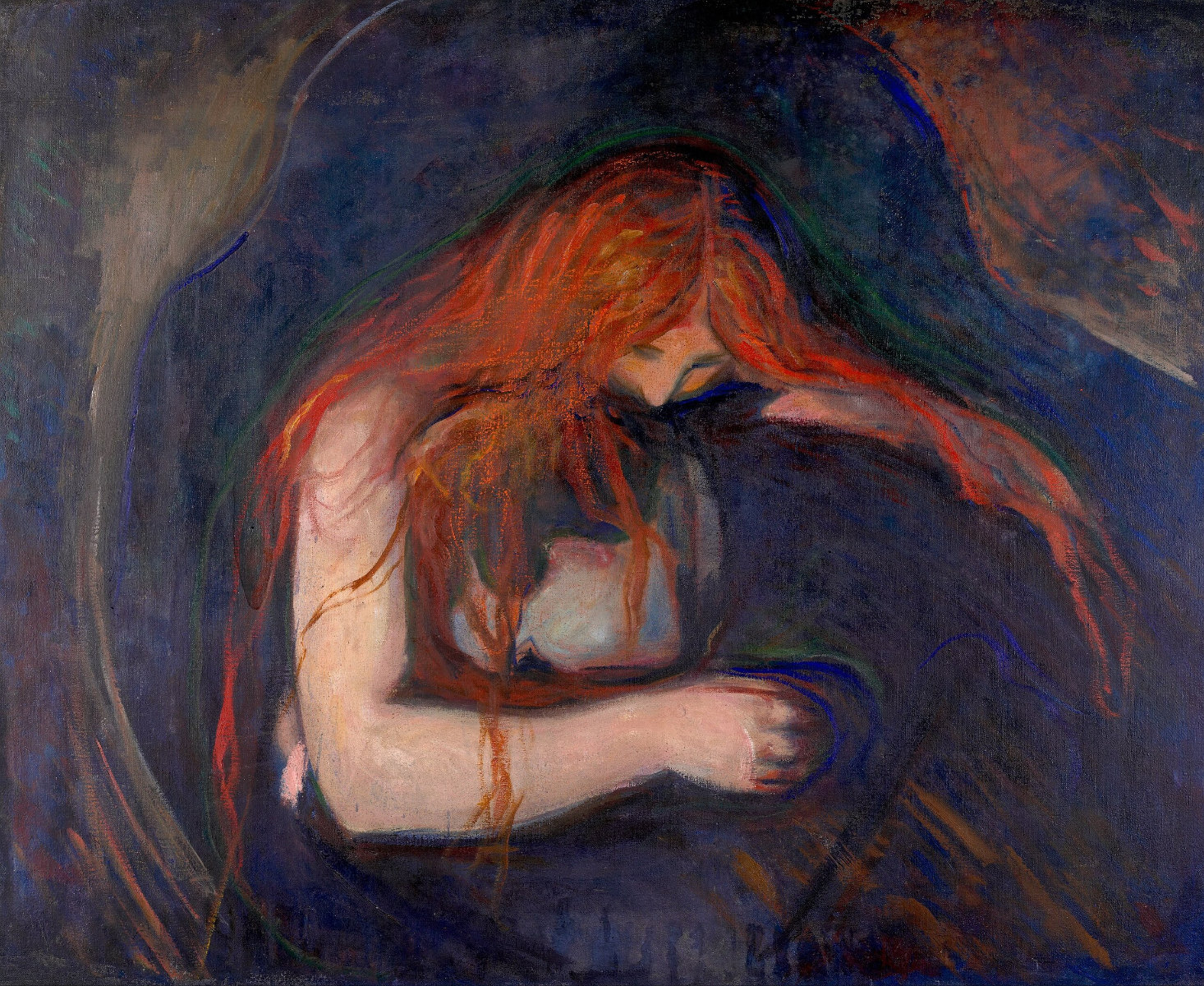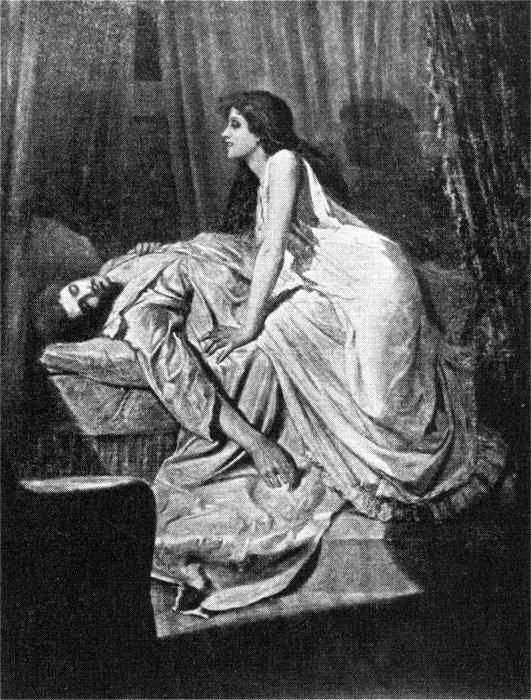A vampire is a mythical creature that subsists by feeding on the vital essence (generally in the form of blood) of the living. In European folklore, vampires are undead humanoid creatures that often visited loved ones and caused mischief or deaths in the neighbourhoods which they inhabited while they were alive. They wore shrouds and were often described as bloated and of ruddy or dark countenance, markedly different from today’s gaunt, pale vampire which dates from the early 19th century. Vampiric entities have been recorded in cultures around the world; the term vampire was popularized in Western Europe after reports of an 18th-century mass hysteria of a pre-existing folk belief in Southeastern and Eastern Europe that in some cases resulted in corpses being staked and people being accused of vampirism. Local variants in Southeastern Europe were also known by different names, such as shtriga in Albania, vrykolakas in Greece and strigoi in Romania, cognate to Italian strega, meaning “witch”. In modern times, the vampire is generally held to be a fictitious entity, although belief in similar vampiric creatures (such as the chupacabra) still persists in some cultures. Early folk belief in vampires has sometimes been ascribed to the ignorance of the body’s process of decomposition after death and how people in pre-industrial societies tried to rationalize this, creating the figure of the vampire to explain the mysteries of death. Porphyria was linked with legends of vampirism in 1985 and received much media exposure, but has since been largely discredited. The charismatic and sophisticated vampire of modern fiction was born in 1819 with the publication of “The Vampyre” by the English writer John Polidori; the story was highly successful and arguably the most influential vampire work of the early 19th century. Bram Stoker’s 1897 novel Dracula is remembered as the quintessential vampire novel and provided the basis of the modern vampire legend, even though it was published after fellow Irish author Joseph Sheridan Le Fanu’s 1872 novel Carmilla. The success of this book spawned a distinctive vampire genre, still popular in the 21st century, with books, films, television shows, and video games. The vampire has since become a dominant figure in the horror genre…
| Alias Vampires |
| Real Names/Alt Names Vampire, Shtriga, Vrykolakas, Strigoi, Nosferatu |
| Characteristics Villain, Film Characters, Literary Characters, Myths & Legends, Newspaper Strip Characters, Wold Newton Universe, Vampire, Hypnotist, Shapeshifter, Enlightenment and Neoclassicism |
| Creators/Key Contributors ○ |
| First Appearance European folklore |
| First Publisher ○ |
| Appearance List Literary: The Vampire (1748), Lenore (1773), The Bride of Corinth (1797), Thalaba the Destroyer (1801), The Giaour (1813), The Vampyre (1819), The Family of the Vourdalak (1839), Varney the Vampire/Feast of Blood (1845–47), The Dark Blue vol. 2 (Dec. 1871), Dracula (1897), Powers of Darkness – Swedish Version (1899), The Vampire Maid (1900), Powers of Darkness – Icelandic Version (1901), Ghost Stories of an Antiquary (1904), Count Magnus, Dracula’s Guest and Other Weird Stories (1914), The Hypnotist (1918), The Return of the Undead (1925), The Canal (1927), The Horror from the Mound (1932), The Brotherhood of Blood (1932), The Dark Castle (1932), Vampire Village (1932), The Fire Vampires (1933), The House of Shadows (1933), The Nightmare Road (1934), The Feast in the Abbey (1935), Four Wooden Stakes (1936), Doom of the House of Duryea (1936), I, the Vampire (1937), The Silver Coffin (1939), Father’s Vampire (1952). Theater: Dracula, or The Undead (1897), Dracula – Original Production (1924), Dracula – Broadway Version (1927). Film: Dracula’s Death (1921), Nosferatu (1922), London After Midnight (1927), Dracula (1931), Mark of the Vampire (1935), Dead Men Walk (1943), Plan 9 from Outer Space (1959), Billy the Kid Versus Dracula (1966), The Satanic Rites of Dracula (1973). Comics: |
| Sample Read Dracula (1897) [Standard eBooks] |
| Description A vampire is a mythical creature that subsists by feeding on the vital essence (generally in the form of blood) of the living. In European folklore, vampires are undead humanoid creatures that often visited loved ones and caused mischief or deaths in the neighbourhoods which they inhabited while they were alive. They wore shrouds and were often described as bloated and of ruddy or dark countenance, markedly different from today’s gaunt, pale vampire which dates from the early 19th century. Vampiric entities have been recorded in cultures around the world; the term vampire was popularized in Western Europe after reports of an 18th-century mass hysteria of a pre-existing folk belief in Southeastern and Eastern Europe that in some cases resulted in corpses being staked and people being accused of vampirism. Local variants in Southeastern Europe were also known by different names, such as shtriga in Albania, vrykolakas in Greece and strigoi in Romania, cognate to Italian strega, meaning “witch”. In modern times, the vampire is generally held to be a fictitious entity, although belief in similar vampiric creatures (such as the chupacabra) still persists in some cultures. Early folk belief in vampires has sometimes been ascribed to the ignorance of the body’s process of decomposition after death and how people in pre-industrial societies tried to rationalize this, creating the figure of the vampire to explain the mysteries of death. Porphyria was linked with legends of vampirism in 1985 and received much media exposure, but has since been largely discredited. The charismatic and sophisticated vampire of modern fiction was born in 1819 with the publication of “The Vampyre” by the English writer John Polidori; the story was highly successful and arguably the most influential vampire work of the early 19th century. Bram Stoker’s 1897 novel Dracula is remembered as the quintessential vampire novel and provided the basis of the modern vampire legend, even though it was published after fellow Irish author Joseph Sheridan Le Fanu’s 1872 novel Carmilla. The success of this book spawned a distinctive vampire genre, still popular in the 21st century, with books, films, television shows, and video games. The vampire has since become a dominant figure in the horror genre… |
| Source Vampires – Wikipedia |



